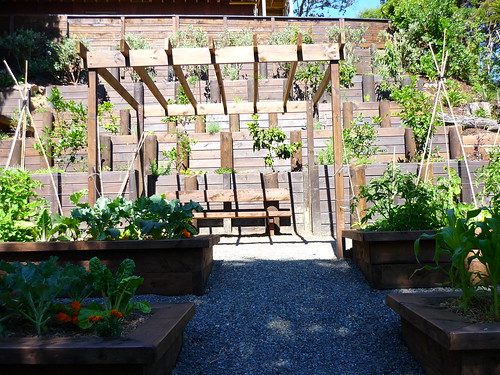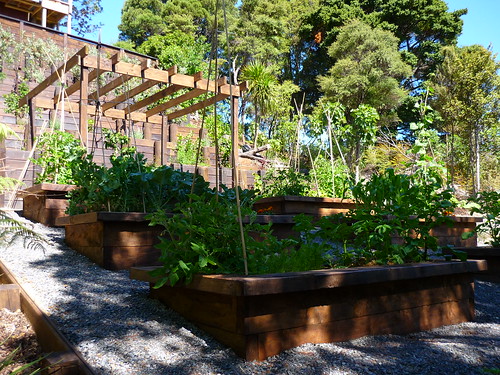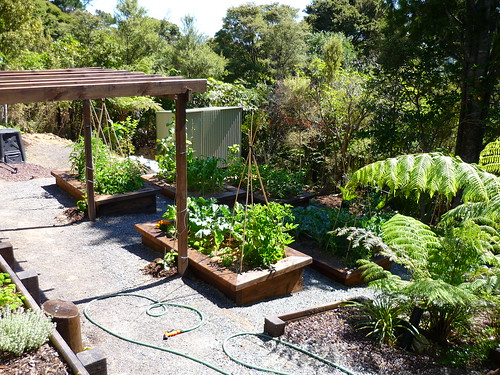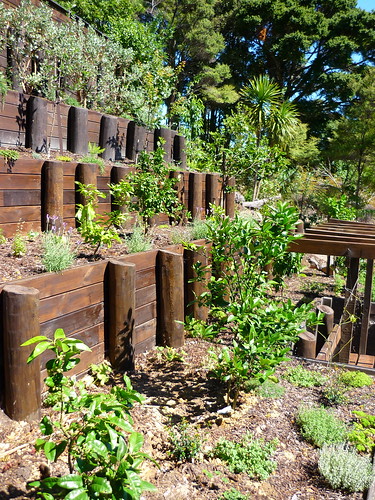Kitchen Gardens
Tuesday, 3 February 2009 by Dr Maytel
I have been writing my second to last chapter lately on vegetables. Within agricultural development ciricles it is a well known fact that the emergence of fresh fruit and vegetable commodity chains are indisputably linked with a rise in development and propserity specifically of the middle class urban dwellers. Growth and propserity in Asia in recent years has seen the proliferation of fresh fruit and vegetable production and marketing, with this region now accounting for over fifty per cent of worldwide production. Most of thise produce is consumed locally if not regionally.
In Cambodia, kitchen gardens are a common sight around the raised household lands or river banks where the perils of flooding are diminished. These polycultures are known in Khmer as chamcar. More recently specilaised growers have emerged in nearby provinces supplying the growing consumer market. But still, for the most part, kitchen gardens in Cambodia exist to service the day to day non-market needs of domestic kitchens
On the other side of the world vegetable gardening has seen a resurgence in the developed world. Garden centres have reported increased sales during the financial crisis as people turn to cheaper hobbies that also provide sustenance.
Growing your own occupies a special place in a lot of people's psyches. My own little vegetable patch in Canberra gives me unique sense of satisfaction, and I find myself often memorised by my vege.
It is however, far more of a hobby than it could ever be called "livelihood strategy". For that I would need a much larger plot, seedling production centre and possibly be growing some grain as well.
But for now I potter and I gaze. I relish in the fact that my strawberries are so happy and I am puzzled by my tomatos sad performance.
It seems that in the west the history of kitchen gardens has always been an earthly pursuit of the wealthy or middle classes, first emerging as part of the economies of large feudal estates, and toiled by estate workers to cultivate and provide the freshest and most seasonal and sometimes exotic varieties to the tables of their masters. I read this in the History of Food book, which also noted that the popularity of kitchen gardens grew tremendously in France with the rise of the bourgeoisie.
My sister's has a kitchen garden of this order,of course, in true big sister style the eldest has the most enviable of gardens, carved out the clay soils of the Waitakere ranges, the garden is unlikely to ever "pay" for itself in vegetable yield terms, least the entire world meltdowns and New Zealand remains cut off from international trade and the film industry in which she works (an event it seems that my sister is apparently prepared for giving her predilection to hoard cans of food and bottles of wine)

The garden cascades down the hill from fruit tree terraces lined with feijoas and heirloom variety pears, limes, grapefruit, lemons, peaches etc etc which is interspearsed with edible herbs and other vegetables such as squashes, cabbages and cucumbers. The pergola with sitting bench is framed by two grape varieties to the side and passionfruit vines to the front

The raised beds are planted at the moment with summer vegetables of all variety, corn, tomatoes, potatos, raddishes, peas, beans.....These are interspeared with marigolds and other herbs

Plans are afoot to start bee hives behind the garden shed too
The garden gets a lot of sun but is sheltered from wind by native New Zealand bush. Around the outer borders before the bush begins are strawberries, sage, tamarillos trees.
Finally there is a platform suspended up the terraces where one may lounge in partial shade , read a book and survey with satisfaction the view of fruit and vegetables growing.

This garden truely out does my modest patch of dirt, it verges on an estate garden in my books and fulfils in all my family's pastoral fantasies that our middle class status permits us to have....When I'm there I wander around the garden, picking off sprigs of herbs for making salsa verde. My other sisters like to sit and wander too. But of course my sister has a gardener that comes a couple of times a week to look after the garden, she is after all very busy making money "off-farm"
Which brings me to all the kerfuffle about the White House garden and the Alice Watery and Michael Pollan demands for the White House to dig up the lawn and plant an organic vegetable garden. This is in some way supposed to be "symbolic" of the presidents commitment to good fresh local food, and a commitment to transforming the american agricultural system from the pit of disaster that it currently is..... But should the Obamas capitulate to these requests by middle class food champions? Should the White House be aiming to fulfil the pastoral daydreams of Alice Waters by planting an organic garden. They'll be no shortage of serfs this year to tend these gardens no doubt.....or should Obama not worry so much about the front lawn and concern himself with the very real challenges of transforming the agricultural system and rural communities, rethinking farm policies and introducing a new farm bill?
In Cambodia, kitchen gardens are a common sight around the raised household lands or river banks where the perils of flooding are diminished. These polycultures are known in Khmer as chamcar. More recently specilaised growers have emerged in nearby provinces supplying the growing consumer market. But still, for the most part, kitchen gardens in Cambodia exist to service the day to day non-market needs of domestic kitchens
On the other side of the world vegetable gardening has seen a resurgence in the developed world. Garden centres have reported increased sales during the financial crisis as people turn to cheaper hobbies that also provide sustenance.
Growing your own occupies a special place in a lot of people's psyches. My own little vegetable patch in Canberra gives me unique sense of satisfaction, and I find myself often memorised by my vege.
It is however, far more of a hobby than it could ever be called "livelihood strategy". For that I would need a much larger plot, seedling production centre and possibly be growing some grain as well.
But for now I potter and I gaze. I relish in the fact that my strawberries are so happy and I am puzzled by my tomatos sad performance.
It seems that in the west the history of kitchen gardens has always been an earthly pursuit of the wealthy or middle classes, first emerging as part of the economies of large feudal estates, and toiled by estate workers to cultivate and provide the freshest and most seasonal and sometimes exotic varieties to the tables of their masters. I read this in the History of Food book, which also noted that the popularity of kitchen gardens grew tremendously in France with the rise of the bourgeoisie.
My sister's has a kitchen garden of this order,of course, in true big sister style the eldest has the most enviable of gardens, carved out the clay soils of the Waitakere ranges, the garden is unlikely to ever "pay" for itself in vegetable yield terms, least the entire world meltdowns and New Zealand remains cut off from international trade and the film industry in which she works (an event it seems that my sister is apparently prepared for giving her predilection to hoard cans of food and bottles of wine)

The garden cascades down the hill from fruit tree terraces lined with feijoas and heirloom variety pears, limes, grapefruit, lemons, peaches etc etc which is interspearsed with edible herbs and other vegetables such as squashes, cabbages and cucumbers. The pergola with sitting bench is framed by two grape varieties to the side and passionfruit vines to the front

The raised beds are planted at the moment with summer vegetables of all variety, corn, tomatoes, potatos, raddishes, peas, beans.....These are interspeared with marigolds and other herbs

Plans are afoot to start bee hives behind the garden shed too
The garden gets a lot of sun but is sheltered from wind by native New Zealand bush. Around the outer borders before the bush begins are strawberries, sage, tamarillos trees.
Finally there is a platform suspended up the terraces where one may lounge in partial shade , read a book and survey with satisfaction the view of fruit and vegetables growing.

This garden truely out does my modest patch of dirt, it verges on an estate garden in my books and fulfils in all my family's pastoral fantasies that our middle class status permits us to have....When I'm there I wander around the garden, picking off sprigs of herbs for making salsa verde. My other sisters like to sit and wander too. But of course my sister has a gardener that comes a couple of times a week to look after the garden, she is after all very busy making money "off-farm"
Which brings me to all the kerfuffle about the White House garden and the Alice Watery and Michael Pollan demands for the White House to dig up the lawn and plant an organic vegetable garden. This is in some way supposed to be "symbolic" of the presidents commitment to good fresh local food, and a commitment to transforming the american agricultural system from the pit of disaster that it currently is..... But should the Obamas capitulate to these requests by middle class food champions? Should the White House be aiming to fulfil the pastoral daydreams of Alice Waters by planting an organic garden. They'll be no shortage of serfs this year to tend these gardens no doubt.....or should Obama not worry so much about the front lawn and concern himself with the very real challenges of transforming the agricultural system and rural communities, rethinking farm policies and introducing a new farm bill?
